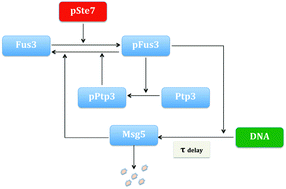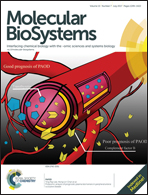Mathematical modeling reveals differential regulation of MAPK activity by phosphatase proteins in the yeast pheromone response pathway
Abstract
To prevent indefinite cellular responses to external signals, cells utilize various adaptation mechanisms. The yeast mating-response pathway is a model cellular system that exhibits adaptation to persistent external signals. This pathway employs a mitogen-activated protein kinase (MAPK) cascade which is composed of two well-known negative feedback inhibitions that involve the yeast phosphatase proteins Ptp3 and Msg5. The phosphorylated form of the yeast MAPK protein Fus3 (pFus3) triggers the phosphorylation of both phosphatases, but transcriptionally upregulates only Msg5. To study the biological rationale for the existence of two distinct negative feedback inhibitions acting on pFus3, we used published experimental data to develop a mathematical model which quantifies the inhibitory roles of these phosphatase proteins on pFus3. Our analyses show that the inhibition of pFus3 due to Ptp3 is largely independent of the signal profile, and is most impactful at early time points after pheromone induction. Conversely, the feedback inhibition due to Msg5 is highly dependent on the signal profile, and is most influential after pFus3 attains its maximum cellular abundance. Similarly, Ptp3 reduces the variation in the pFus3 dynamics at early time points while the noise-reduction effects of Msg5 become stronger as time passes.



 Please wait while we load your content...
Please wait while we load your content...